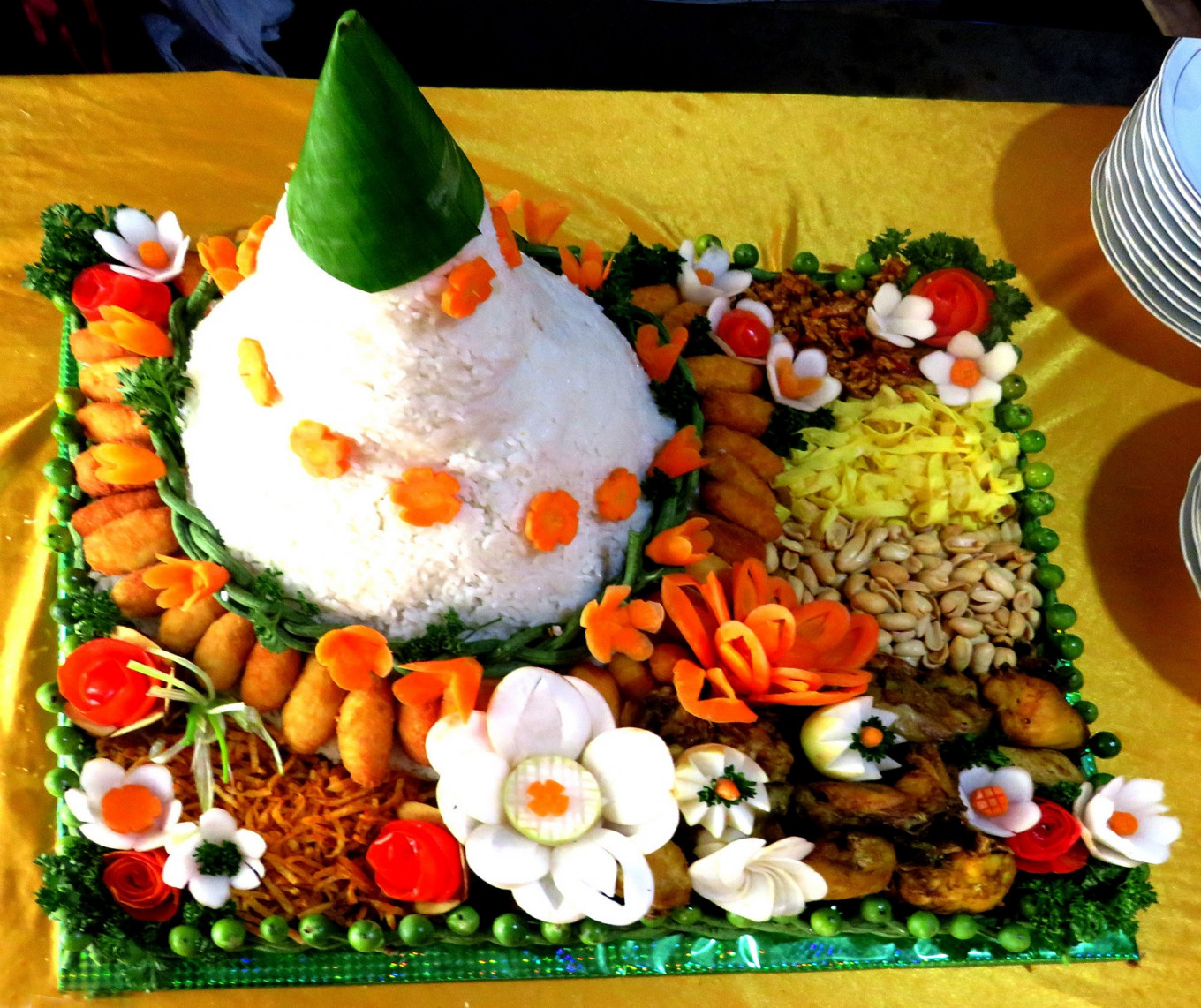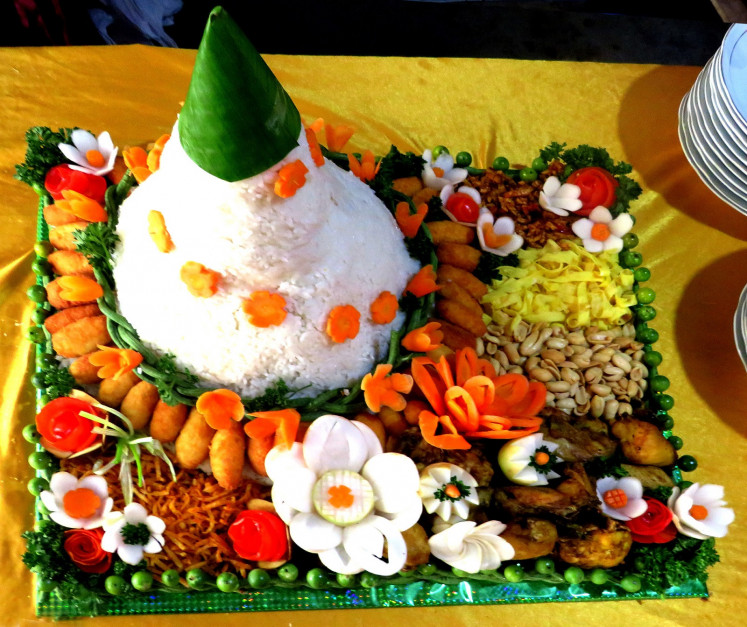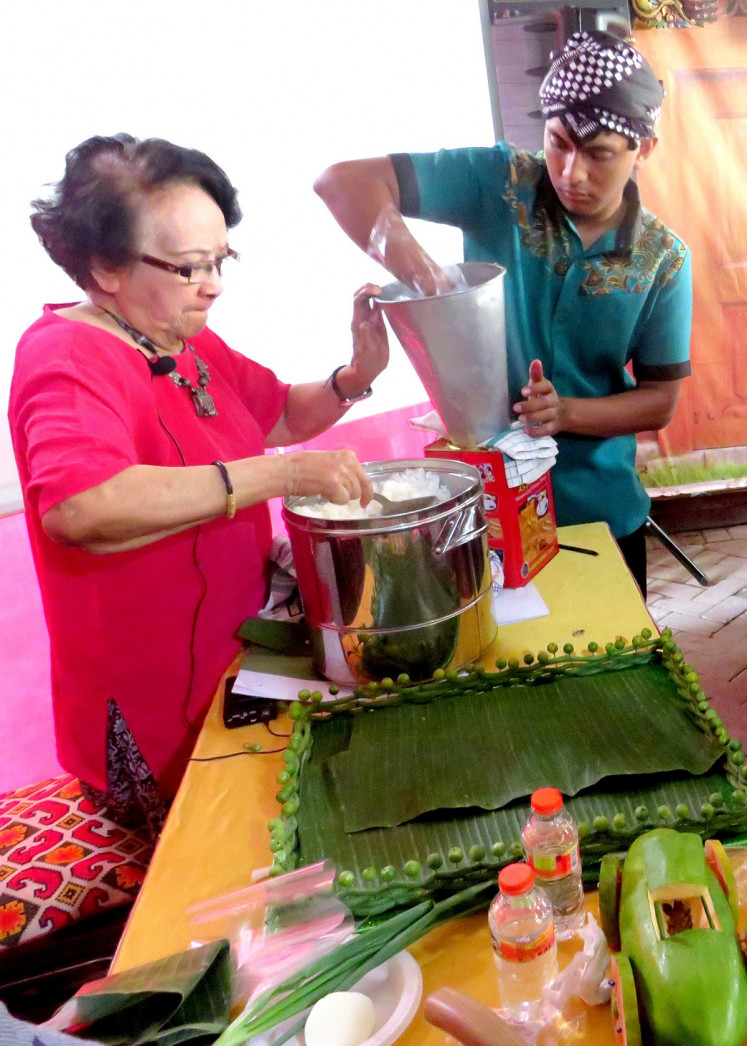Popular Reads
Top Results
Can't find what you're looking for?
View all search resultsPopular Reads
Top Results
Can't find what you're looking for?
View all search resultsThe philosophical significance of Indonesia's ‘tumpeng’
The cone-shaped rice dish known as tumpeng is an inseparable part of celebrations and other important events in Indonesia, and it has a whole lot of meaning attached to it.
Change text size
Gift Premium Articles
to Anyone
The cone-shaped rice dish known as tumpeng is an inseparable part of celebrations and other important events in Indonesia.
While there can be no doubt about the popularity of tumpeng across all segments of Indonesian society, the public’s understanding of its philosophical values is less clear.
For Raden Ayu Koes Dwayati Soegondo, the tumpeng, more than just a culinary specialty of a bygone era, is steeped in hidden meanings.
Ayu, who has been working as a tumpeng instructor since the 1970s, describes how the tumpeng symbolizes the journey of life.
“Its basic philosophy is that the more suffering we have to endure, the more mature we become, as reflected in the process of preparing the tumpeng by heaping rice until it becomes anteng (steady),” she said during a recent tumpeng workshop at the Soendari Batik & Art Gallery in Malang, East Java.
According to Ayu, the other meaning of the tumpeng is inherent in its pointed cone, symbolizing the devotion toward the one God. The shape also alludes to the mountainous landscape of many Indonesian regions, particularly Java. The dishes around the cone signify the vegetation, forests and wildlife.
Ayu mentioned various kinds of tumpeng made with different styles of rice as the basic component, from white rice, to uduk rice (cooked with coconut milk) and yellow rice. White rice is the principal choice traditionally.
“White means sinless, and it is meant for traditional ceremonies in Java, such as birthdays, seventh-month pregnancy, pasaran [a day of the Javanese five-day week], wetonan (Javanese-week based birthday) and gusur tanah [land clearance],” said Ayu.
Uduk rice comes from the word wudhu, meaning the cook has to perform ritual ablutions, because the rice is preferred for Islamic religious events like Ashura and Mawlid.
Lastly, yellow rice is the most commonly found tumpeng, served at events ranging from birthday parties to office inaugurations.
Ayu said that, for cooks familiar with the tumpeng philosophy, the cone model should be mandatory for white rice.
“Uduk and yellow rice tumpeng can be modified according to the customer’s orders,” added Ayu.
As for side dishes, bean sprouts and long beans in the form of urap-urap (mixed with grated coconut) are aimed at promoting interaction and friendliness. Botok tawon (bees with grated coconut) symbolizes the character of bees, which are beneficial, always needed and make a lot of friends.
Ayam ingkung (whole chicken with head facing upward) signifies a gesture in the direction of God, and rempeyek teri (small fried chips) is intended to depict harmony.
Boiled eggs portray inner gentleness behind one’s stern appearance.
“The egg white symbolizes virtuousness and the yolk stands for the light of God, so that humans should maintain virtuous deeds and always be close to God,” said Ayu.
Catfish is also a common side dish, and it represents a humble attitude, because fish are always under water.
The side dishes for uduk and yellow rice cone are essentially the same as those for the white cone, only with some additions, like ox or chicken liver and tempeh or potatoes cooked in sambal goreng (spicy condiment with chili peppers or coconut milk), raw cucumbers and potato croquettes.
Ayu assumed that tumpeng was first made by Indonesians when people used kukusan (cone-shaped bamboo baskets) to cook rice.
She was convinced that the tumpeng had nothing to do with Hinduism, because India had no tradition of rice cones similar to Indonesia. The influence of Indian culture, noted Koes Dwayati, only involved some modification, such as adding turmeric to make yellow rice.
“I also believe the tumpeng was introduced when most people were illiterate, because it is packed with moral teachings,” she said. This fact shows the aspirations of the ancestors of today’s Indonesians to provide education through food symbolism.
Ayu finally referred to tumpeng as a manifestation of gotong royong (mutual assistance) as a typical characteristic of Indonesians.
“The process of making tumpeng involves teamwork for mutual enjoyment,” she concluded.
A lecturer of anthropology at Malang’s Brawijaya University, Ary Budianto, said at a separate occasion that, based on Kakawin Bomakawya (old Javanese poetry) of the 12th – 13th century, the tumpeng was a Javanese tradition of laying down food to create a large heap.
“At the time, kingdoms received tributes from their people, and tumpengan was an occasion to allow people to dine together with royal circles,” he said.
Ary added that, in Javanese society, there was no significant difference between the food consumed by royal families and the common people.
He pointed out that culinary differences between social classes first emerged in the colonial era, beginning with the growth of industries like those of sugar and coffee.
The Tumpeng indeed originated in Java, Ary said, but its presence remained affected by ancient Indian Hindu-Buddhist culture, especially concerning Mount Semeru. It became typically Javanese due to local distinction.
The era of Islam entering Java also affected the tumpeng, as reflected in the grebeg religious procession introduced by Sultan Agung in the 17th century, which involved the tumpeng.
Coastal people have since held Petik Laut, a marine thanksgiving ritual that involves floating a giant tumpeng. Ary is concerned about the fading philosophical significance attached to the tumpeng.
In his view, the tumpeng today serves merely as a complement to ceremonial events.
“Tumpeng with all its philosophy is a manifestation of our agrarian society. Each of the components tells us something about the process of human life," he stressed.













